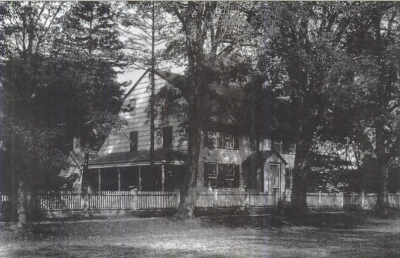The Mast-Head: Not a Ghost Story

Sometime in the mid-1970s, my friend Mike moved into a house set back a good way from Main Street, behind what is now the Ladies Village Improvement Society headquarters. I had never paid much attention to the old place until Mike and his mom were there and it became kind of a home away from home for me, but on nights when we happened to be walking by after dark, coming back from some mischief or other, it gave me the shivers. Little did I know.
This is not a ghost story, per se, but let’s say if I believed in ghosts, I would most certainly think the big house was haunted.
The Gardiner Brown house, as it was known before the L.V.I.S. set up shop there, stood much closer to the street until 1924. It was called brown because it was brown in color in its later years. The Gardiner White House, occupied as a summer home briefly by President John Tyler and his wife, the former Julia Gardiner, was up the street. It lost its roof in the 1938 Hurricane and was demolished.
When the brown house was built for David Gardiner, the fourth proprietor of Gardiner’s Island, in 1740, its front door was about where a white pole-and-picket fence stands today. At some point, a sidewalk was laid along the street, which stopped abruptly at the Gardiners’ stone steps, then resumed on the other side — on the other hand, perhaps one of the family, vexed about the intrusion, had the steps built over the sidewalk.
During the Revolutionary War, when the British occupied East Hampton, Redcoat officers billeted in the house. Tradition has it that their revelries offended the natives. Much later, another David Gardiner raised half-cow, half-bison hybrids there much to the amusement of the local children who would peep at them through a rear fence. The history of the house was presented recently by Chip Rae as part of a program at the East Hampton Library on the Gardiner properties at the East Hampton Library, which will shortly be available on-demand at the LTV website.
For Mike and me, things got creepy when we were roughly in the eighth grade and the house caught fire, killing an older man who lived there alone. The story we heard somehow, whether accurate or not, was that while his torso was recovered from the debris, his head was not.
For what seemed like months to us, a Dumpster remained in the driveway at the side of the house’s gutted east wing. At night, wading through the damp smell of burned wood we imagined the man’s missing skull hidden deep inside and quickened our step. To our young minds, it seemed reasonable that there had been a murder and that the perpetrator had set the fire to hide the evidence.
We never found out anything more, but to this day it is difficult for me not to think about the old man’s head even when browsing among the books in the L.V.I.S. shop inside — never mind passing by, late at night, on foot.
Happy Halloween.
